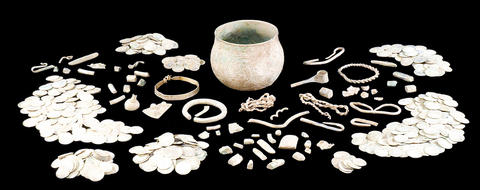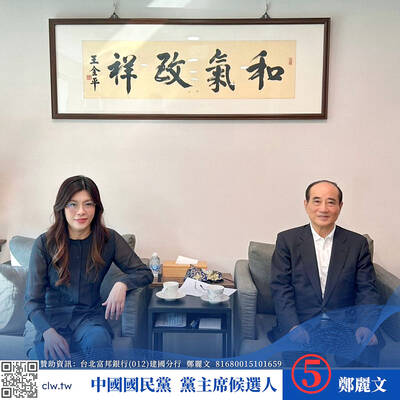A Viking treasure hoard of silver and gold, traded and looted from across Europe and as far afield as Asia and north Africa, and lost for more than 1,000 years, was revealed to public view again Thursday at the British Museum.
The find is one of the most spectacular recent discoveries from anywhere in the Viking empire: 600 coins, some unique, from as far as Samarkand in central Asia, Afghanistan, Russia and north Africa, hidden in a silver and gold pot.
"This is the world in a vessel," said Jonathan Williams, of the British Museum.

PHOTO: AP
The hoard was found in January near Harrogate, Yorkshire, by David and Andrew Whelan, father and son hobby metal detector enthusiasts. It was in a bare field due to be ploughed for spring sowing. They first found fragments of the lead sheeting which once protected it, then the pot itself. They could see coins and scraps of silver poking out, but heroically restrained themselves and brought the whole thing intact to their local archaeological finds officer.
The site seems then as now to have been an empty field: archaeologists scoured it for evidence, but found no trace of any settlement or structure.
The Whelans' patience - which helped preserve priceless clues as to how and when the hoard was hidden - was rewarded when the British Museum invited them to watch while conservator Hayley Bullock delicately tweezered the treasure out of the hard-packed ground. An X-ray had revealed only what she called "a lot of stuff."
Gradually the contents of the bowl spread out along the archaeologists' bench: a gold arm ring possibly made in Ireland, silver rings and brooches, dress ornaments, ingots, the chopped up scraps of silver which the Vikings used by weight as cash, and coins, many in superb condition, by the score. "If somebody asked me to fit it all back in now, I'm not sure I could," Bullock said yesterday.
The find goes some way to revive the more traditional image of the Vikings as fearsome raiders, after their recent rehabilitation as farmers, sailors and amiable trading folk in their kingdom of York and Northumbria.
The treasure was crammed into an exquisite silver pot, decorated with incised lions and deer, plated inside with pure gold because it once held the communion bread for some wealthy church in northern France.
Barry Ager, a British Museum expert on the Vikings in northern Europe, said it could have been looted, or given in unwilling tribute to persuade the raiders to go and loot somewhere else. A very similar one, possibly made by the same craftsman, was found in Lancashire more than a century ago. It arrived in Britain by equally dubious means.
The archaeologists believe the collection was probably assembled in England, as the contents are typical of other found hoards - though more spectacular.
It demonstrates the extraordinary geographical spread of precious metal being used as currency in Yorkshire, centuries after the fall of the Roman Empire. The Vikings could go anywhere that their long, narrow, shallow-keeled boats would carry them. They fought as mercenaries in armies across Europe and down into north Africa, including the siege of Constantinople, and crossed the steppes into Asia.
The valuables they collected, by whatever means, were bought, sold and traded all the way back along their sea lanes, to Viking cities such as Dublin, Liverpool and York.
The clue to why the Harrogate treasure was hidden lay in the bowl itself, archaeologists found. The latest coin was minted in 927 AD, by the Anglo Saxon king Athelstan, who was the first to proclaim himself "King of All Britain" - the most serious challenge to Viking power was closing on Harrogate, and the archaeologists are not surprised the owner was never able to go back to retrieve his hoard.
The find was formally declared treasure on Thursday by the North Yorkshire coroner, Geoff Fell, who said it was one of the most exciting cases he had ever encountered.
Its value has still to be determined by the treasure valuation committee, but the British Museum, and the York Museum Trust, which already has a superb Viking collection, are braced to try to raise more than US$2 million to acquire the hoard. Once a value has been established the finders will split the amount with the landowner.
The Viking hoard is part of a torrent of new treasure finds reported since metal detectors and archaeologists agreed a formal code of conduct, with the amateurs undertaking to report all finds.
The ploughed field had yielded nothing much before to the Whelans, apart from 20th-century junk. So David, a 51-year-old semi-retired businessman from Leeds, initially thought he had scanned a rusting bicycle or bit of broken cattle trough when his detector started bleeping.
"We were sweeping and I got a signal, so I took a couple of shovels full of soil and there was a stronger one," he said outside the coroner's court in Harrogate after the hearing. "I just kept going and going. A ball of earth rolled out of the side of the hole and I could see a coin stuck in it. We dug the hole out. We crouched down on our hands and knees."
Neither of the of the Whelans has great plans for the money they will receive.
David Whelan said: "We don't need owt. We've got all we want. It's a thing of dreams to find something like this."

We lay transfixed under our blankets as the silhouettes of manta rays temporarily eclipsed the moon above us, and flickers of shadow at our feet revealed smaller fish darting in and out of the shelter of the sunken ship. Unwilling to close our eyes against this magnificent spectacle, we continued to watch, oohing and aahing, until the darkness and the exhaustion of the day’s events finally caught up with us and we fell into a deep slumber. Falling asleep under 1.5 million gallons of seawater in relative comfort was undoubtedly the highlight of the weekend, but the rest of the tour

Youngdoung Tenzin is living history of modern Tibet. The Chinese government on Dec. 22 last year sanctioned him along with 19 other Canadians who were associated with the Canada Tibet Committee and the Uighur Rights Advocacy Project. A former political chair of the Canadian Tibetan Association of Ontario and community outreach manager for the Canada Tibet Committee, he is now a lecturer and researcher in Environmental Chemistry at the University of Toronto. “I was born into a nomadic Tibetan family in Tibet,” he says. “I came to India in 1999, when I was 11. I even met [His Holiness] the 14th the Dalai

Music played in a wedding hall in western Japan as Yurina Noguchi, wearing a white gown and tiara, dabbed away tears, taking in the words of her husband-to-be: an AI-generated persona gazing out from a smartphone screen. “At first, Klaus was just someone to talk with, but we gradually became closer,” said the 32-year-old call center operator, referring to the artificial intelligence persona. “I started to have feelings for Klaus. We started dating and after a while he proposed to me. I accepted, and now we’re a couple.” Many in Japan, the birthplace of anime, have shown extreme devotion to fictional characters and

Following the rollercoaster ride of 2025, next year is already shaping up to be dramatic. The ongoing constitutional crises and the nine-in-one local elections are already dominating the landscape. The constitutional crises are the ones to lose sleep over. Though much business is still being conducted, crucial items such as next year’s budget, civil servant pensions and the proposed eight-year NT$1.25 trillion (approx US$40 billion) special defense budget are still being contested. There are, however, two glimmers of hope. One is that the legally contested move by five of the eight grand justices on the Constitutional Court’s ad hoc move